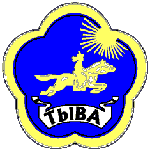TRIP TO CITY OF RUSSIA
TRIP TO CITY OF RUSSIA
WELCOME TO REPUBLIC OF TUVA
ABOUT REPUBLIC OF TUVA

 The republic of Tuva is one of the least known and most curious corners of
Russia. The Tuvans are nomadic pastoralists by nature Buddhist and shamanist by
religion, Mongolian by cultural heritage, and Turkic by language.
The republic of Tuva is one of the least known and most curious corners of
Russia. The Tuvans are nomadic pastoralists by nature Buddhist and shamanist by
religion, Mongolian by cultural heritage, and Turkic by language.
Locals say that Tuva is located in the very center of Asia.
The geometrical center of the Asian continent defined by scientists lies in
Kyzyl – capital of Tuva - and is marked by the stone monument.
Tuva is an area of great variety, with almost every type of
landscape: luxuriant meadows, boundless steppe, medicinal springs, beautiful
lakes, rushing mountain rivers fed in spring by melting snows, dusty
semi-deserts and snowy chains of mountains. The high peaks and alpine lakes of
the Sayan Mountains in south-west of Tuva give rise to the tributaries that
merge to become the mighty Yenisei, one of Siberia's major rivers flowing over
2000 miles to the Arctic Ocean.
This magic land is famous for its unique nature reserves,
traditional festivals and customs (wrestling, throat-singing, etc.) and a
mixture of Buddhist and shamanist beliefs of its people.
The Republic of Tuva (Tannu Tuva) is located in the Tannu
Mountains on the Siberian border in northwestern Mongolia. Tuva encompasses
64,000 square miles and a population of 308,000. Located in southern Siberia and
on the edge of Mongolia, Tuva extends from the coniferous forests of the taiga
in the north to the rolling steppe of the south.
The climate of the region is sharply continental: the lowest
temperatures in winter fall down to 45-50 degrees below zero Centigrade, in
summer temperature may be as high as 38 degrees Centigrade.
The Tuvans form about two-thirds of the republic’s 300,000 population (most
of the rest are Russians). Despite the development of modern technologies and
market economy in Russia, most of the Tuvan population is still semi-nomadic,
moving their herds out from their villages to summer pastures where they live in
yurts. The range of animals that they herd reflects Tuva’s crossroads
character- camels, yaks, cows, horses, goats, sheep, and even reindeer in the
eastern forests.
REPUBLIC OF TUVA. HOW TO GO
- Air
Flights are scheduled to/from Moscow (6 hours, weekly), Novosibirsk (2 hours, three or four times weekly),Irkutsk (2 hours, weekly), and to Kyzyl-Mazhalyk (around 2 hours) and Mugur-Axy (1,5 hours), both daily except Sunday, as well as to Kungurtug (1,5 hours, daily). There are also regular services to other destinations in Tuva.
- Bus
Buses to/from Abakhan run three times daily (around 10 hours). At least one Sunday bus service goes to Novosibirsk (about 28 hours), and daily services run to/from Shagonar (1,5 hours), Ak-Dovurak (7 hours) and Teeli (9 hours).
- Boat
In summer, boats go every two or three days up the Bolshoi Yenisey to Toora-Khem near Lake Azas. The trip upstream is 12 hours, but eight hours coming back downstream.
PAGES OF THE PICTURE ALBUM
|